 Pirates and Privateers Pirates and Privateers
The History of Maritime
Piracy
Cindy Vallar, Editor
& Reviewer
P.O. Box 425,
Keller, TX 76244-0425
    
Merchant,
Pirate, Smuggler, Sea Lord
As students of history, we like facts:
birth year, birthplace, specific events,
et cetera. The past is rarely so
accommodating, especially for those of
humble beginnings. Our searches of
historical annals reveal early lives are
steeped in mystery or conflict and raise
more questions than they answer. This is
particularly true the further back in time
a person lives and when those records are
destroyed, either accidentally or to
eradicate the past. In the case of Zheng
Zhilong and his descendants, it is the
latter reason for the paucity because of
destruction wrought by authorities of the
Qing dynasty. Still, some traces of his
youth exist.
The first dilemma we face concerns his
name. Zheng Zhilong is how we refer to him
today, Zheng being his surname and Zhilong
his given name. (The name has also been
spelled Cheng Chi-lung in the past.) He is
also referred to as Yi-Guan, which means
“First Son,” a word that the Portuguese
wrote as Iquan. Japanese records list him
as Tei Shiryû or Tei Shiryū. Those written
by Europeans refer to him as Nicholas
Iquan, Nicolas Icoan, Nicholas Gaspard or
Jaspar, and Chinchillón.
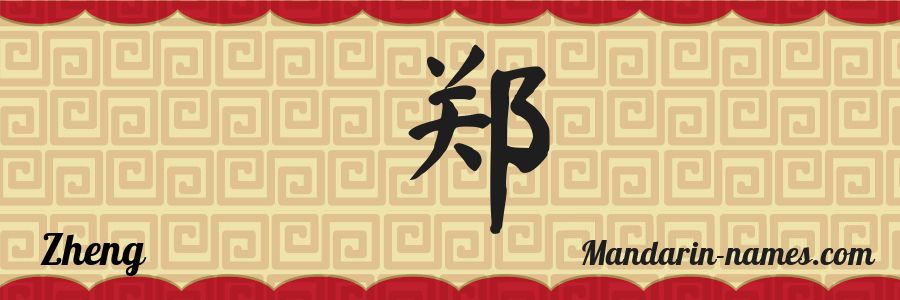 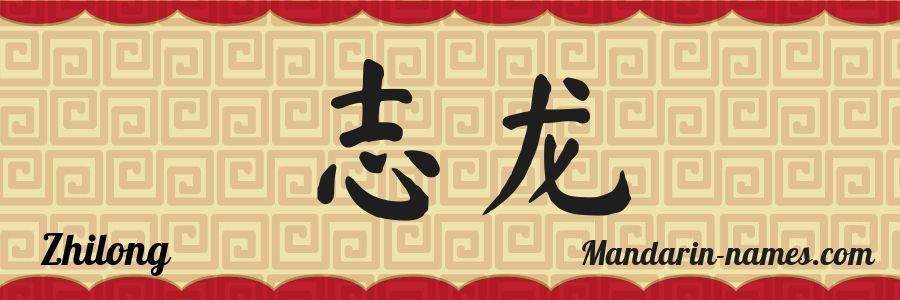
His formal name was Zheng Zhilong, but no
record provides the name he used as a
child or young adult. When he reached the
age of twenty, he participated in a rite
of passage to mark his entry into
adulthood. In Imperial China it was rude
to call an adult by his given name unless
the speaker was of higher rank or an
elder. Instead, he would be addressed by a
courtesy (or style) name, which was deemed
a sign of respect. According to Shao
Tingcai (Shao T’ing-ts’ai), a historian
and philosopher who lived during the
seventeenth century, Zheng Zhilong’s
courtesy name was Fei Huang (Flying
Yellow), which came “from the Chinese
proverb feihuang tengda, “to make
rapid advances in one’s career.” (Antony,
Pirates, 113). Or his courtesy name
might have been Feihong (Flying Rainbow),
a name still associated with Zheng Zhilong
in 1640.
Within the pages of Taiwan
Wai zhi (also spelled Taiwan
waiji and written in the late
1660s), Jiang Risheng included the exact
date and time of Zheng Zhilong’s birth. He
was born between the hours of seven and
nine on the morning of 16 April 1604.
While many events included in this book
have been verified in other Chinese and
European documents, the writing is often a
mix of fact and fiction, much like what
Captain Johnson did in his General
History of the Pyrates in 1724.
While 1604 might be Zheng Zhilong’s true
birth year, a more probable time span
would be 1590-1610, and this might be
narrowed down further to 1592-1595.
His father was Zheng Shaozu (or Ziangyu or
Shibiao). He worked as a clerk at a grain
storehouse in the Quanzhou prefecture
(district). Ji Liuqi, who was born in 1622
and wrote about the Ming dynasty, believed
that Zheng men had worked as yamen
(government) clerks for several
generations.
Zheng Zhilong’s mother was Theyma (also
known as Lady Huang). She had two
brothers, one of whom was Huang Cheng, a
Macau trader who would play a significant
role in Zheng Zhilong’s later teenage
years.
He had three younger brothers (Bao the
Panther, Feng the Phoenix, and Hu the
Tiger) and three younger half-brothers
(Peng the Roc, Hú the Swan, and Guan the
Stork). It’s also possible that he had
some sisters as well.
Although Zheng Zhilong learned to read and
write before his seventh birthday, he was
never keen on his studies. He was
“good-looking, a skillful poet, a musician
of taste, a dancer of merit, and withal of
pleasing manners.” (Day, 27) He also liked
to box and practice martial arts. He
possessed charisma, charm, courage, and
guile. Instead of attending lessons, he
often prowled the streets, getting into
mischief or fighting, much to his father’s
chagrin. The pair had a contentious
relationship and, according to one
account, the elder Zheng harried his son
through the streets with a stick. Zheng
Zhilong’s only option was to board a ship
and sail to Macau around 1610.
The voyage took a week, but Zheng Zhilong
was not alone. Two of his brothers, Bao
and Hu, accompanied him. At the time,
Macau was one of the few places where the
Portuguese were permitted to trade with
China.
Macau
was an exotic place, a piece of
Portugal on the Chinese coast, with
plazas and priests and tolling bells.
An immense cathedral dominated the
hill in the middle of town, and
Japanese artisans were engraving its
stone façade, carving out ships,
lions, figures in long robes, winged
people playing horns. In one panel a
woman floats above a many-headed
serpent next to a caption that reads,
in Chinese, “Holy Mother stomps the
dragon head.” (Andrade, Lost, 22)
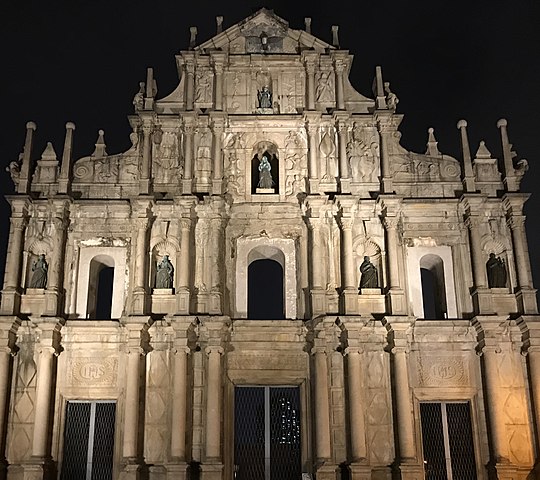
Ruins of Saint Paul's
Cathedral, built by the Jesuits from
1602 to 1640
(Source: Wikimedia
Commons, by No1lovesu)
The port was also the home of his maternal
uncle, Huang Cheng. He owned a trading
company and put his nephews to work. He
deemed education important, but felt
success and wealth were of greater value
than academic achievements. Zheng Zhilong
apparently agreed because he found his
skills more useful here than they had been
back home and he excelled at whatever he
set his hand to.
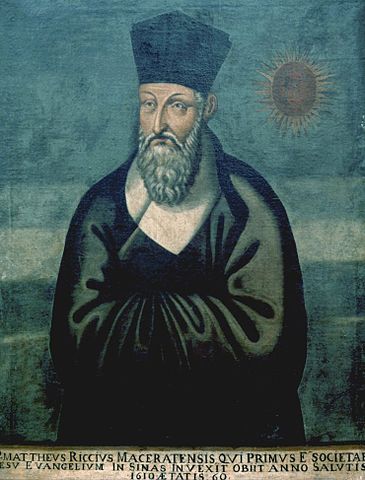 During his
time in Macau, he also met a Jesuit
priest, who befriended Zheng Zhilong and
taught him Portuguese. At some point
between 1615 and 1620, Zheng Zhilong was
baptized in the Catholic faith and became
Nicholas Iquan or Nicholas Iquan Gaspard
(or Jaspar). Whether he remained a devoted
Christian was debatable. Later in his
life, some Portuguese wrote, “[he] was so
impious, or so ignorant, that he equally
burnt incense to Jesus Christ and to his
idols.” (Andrade, Lost, 22) It was
also possible that he still attended mass
until he died. Certainly, he remained in
contact with Jesuits in his later years.
He wrote poems that he sent to Father
Francesco Sambiasi, and while living in
Beijing, he paid to have a house and
chapel built for the priests living in the
city. He also provided funds to them,
arranged for servants to work for them,
and purchased needed goods for their use.
During his final years, when he needed
help, they gave him “decem circiter
aureos,” a gift that “touched the
old man greatly and moved him to tears.” 1
(Vermote, 282) During his
time in Macau, he also met a Jesuit
priest, who befriended Zheng Zhilong and
taught him Portuguese. At some point
between 1615 and 1620, Zheng Zhilong was
baptized in the Catholic faith and became
Nicholas Iquan or Nicholas Iquan Gaspard
(or Jaspar). Whether he remained a devoted
Christian was debatable. Later in his
life, some Portuguese wrote, “[he] was so
impious, or so ignorant, that he equally
burnt incense to Jesus Christ and to his
idols.” (Andrade, Lost, 22) It was
also possible that he still attended mass
until he died. Certainly, he remained in
contact with Jesuits in his later years.
He wrote poems that he sent to Father
Francesco Sambiasi, and while living in
Beijing, he paid to have a house and
chapel built for the priests living in the
city. He also provided funds to them,
arranged for servants to work for them,
and purchased needed goods for their use.
During his final years, when he needed
help, they gave him “decem circiter
aureos,” a gift that “touched the
old man greatly and moved him to tears.” 1
(Vermote, 282)
Zheng Zhilong did many tasks for his
uncle, and when his uncle felt it was time
to test his knowledge and skills, his
uncle put him in charge of an illicit
cargo of “white sugar, calambak wood and
musk.” (Clements, 18) Zheng Zhilong
succeeded in delivering the goods to the
Japanese islands of Ryukyu. Eventually
Huang Cheng trusted Zheng Zhilong with
another important cargo, this one bound to
the port of Hirado, Japan. Here, he would
come in contact not only with the Japanese
but also men and ships from China, the
Dutch Republic, England, Portugal, and
Spain. It was also where he met pirates.
The moves to Macau and Hirado opened a
wider world for Zheng Zhilong, one in
which his charisma, charm, courage, and
guile would prove especially beneficial.
When winds of change blew across China, he
looked to the future, instead of dwelling
in the past. The path was rarely smooth
and required life skills not taught by
academic tutors. His journey of a thousand
miles permitted him to lay the foundation
upon a legacy that his son and grandson
would build.
Before and during Zheng
Zhilong’s lifetime, the Ming emperor
closed China’s borders to foreign trade
and prohibited his people from exporting
Chinese goods to outside ports. In places
where trade was vital, such as Fujian,
these sea bans had devastating effects.
The only way for many merchants and their
families to survive was to resort to
clandestine trade with foreigners. Such
activities often began with smuggling
goods from one location to another.
Initially, they encountered few problems,
but when imperial officials and forces
enforced the sea bans, or Westerners
wished to establish their own footholds in
Asian trade, the smugglers confronted
armed ships. To protect themselves, the
smugglers fortified their vessels with
weapons of their own. When permitted, they
traded legally. When trade was banned,
they plundered other vessels to acquire
desired goods. The incongruity of these
two sides of the coin resulted in a unique
class of piracy, the “merchant-pirates,”
and Zheng Zhilong would become an adept
among them. But first, he needed to
acquire the right skills and knowledge, as
well as suitable connections, and learn
how to combine all these to become an
entrepreneur. The first rung in this
ladder was working with his uncle in
Macao. The second rung was learning
Portuguese. The third rung was venturing
to places like the Ryukyu
Islands, which connected China and
Japan via Formosa, and was a base for
legitimate traders as well as smugglers
and pirates (known as the wakō).2
The fourth rung was reached when Zheng
Zhilong worked for the Vereenigde
Oostindische Compagnie (VOC,
Dutch East India Company), which
established their colonial trading post on
Formosa
(Taiwan). The fifth rung involved visits
to Japan, especially the port of Hirado.
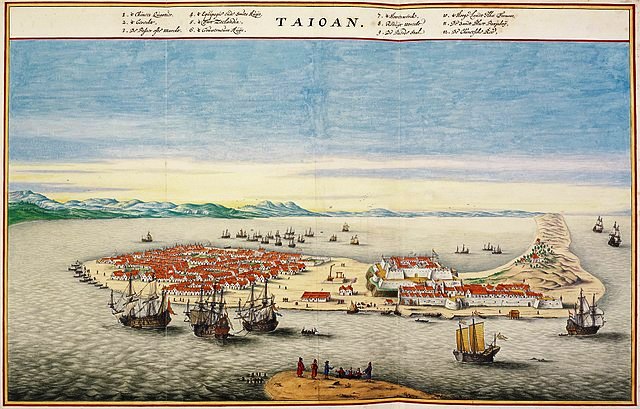 17th-century watercolor by Joan
Blaeu of Dutch colony of Fort Zeelandia on Formosa
17th-century watercolor by Joan
Blaeu of Dutch colony of Fort Zeelandia on Formosa
drawn no earlier than 1644. (Source: Wikimedia
Commons)
While in Japan, Zheng Zhilong met many
people who impacted his life in different
ways. Two men – Li
Dan and Yan Siqi – were traders from
China with significant wealth and
influence. Yan Siqi was a tailor who
realized that “life is as fleeting as the
morning dew,” according to the Taiwan
wai ji, and decided to become a
pirate instead. Little else is known about
him and some scholars are uncertain that
he ever existed.
Li Dan, on the other hand, was a Fujian
merchant, who once served as a slave
chained to the oars of a Spanish ship for
nine years. He was proficient at
identifying people who would be useful to
him, such as financial backers or
protectors (i.e., the Matsura
family who ruled Hirado), and those
he might easily deceive to gain what he
wanted.3
This allowed Li Dan to acquire ships and
create a trading network comprised of
merchants from a variety of cultures,
which permitted him to become the dominant
trader of Chinese goods in the early years
of the seventeenth century. After meeting
Zheng Zhilong, he invited the adventurous
and handsome lad to joined his enterprise,
and it didn’t take long for Zheng Zhilong
to become a favorite of Li Dan’s inner
circle.4
The knowledge he acquired from his mentor
and his associations with others, as well
as his natural talents and aptitude for
languages, gave him an edge. He
communicated effectively and reached
agreements with an eclectic group of
associates – Chinese, Dutch, Japanese,
Portuguese, and Spanish – that permitted
the Zheng clan to eventually dominate all
but ten percent of Chinese shipping for
sixty years.
His personal life also changed in Hirado
when he met the daughter of a low-ranking
samurai.
Tagawa Matsu was a young woman in her
early twenties. Whether he married her or
not is uncertain, but theirs was a true
love match.
In 1623, Li Dan offered Zheng Zhilong the
chance to become his agent in trade with
the Europeans. He also served as an
interpreter and entered into negotiations.
This required him to leave Hirado for the
Pescadores (Penghu Islands) in the Taiwan
Strait. Tagawa, who was pregnant, remained
in Japan.
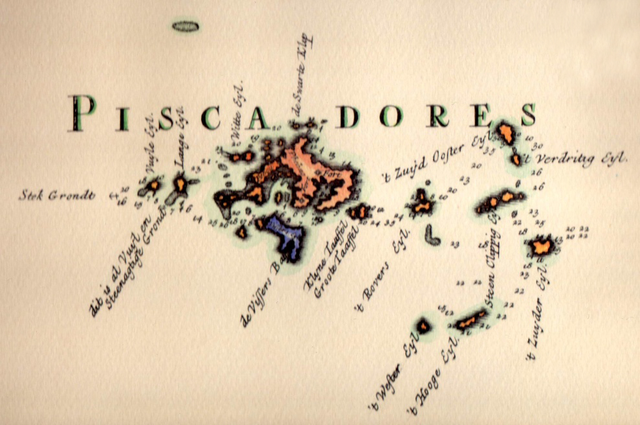
Pescadores Islands c. 1726 from map
drawn by J. van Braam and G. onder de Linden
(Source: Wikimedia
Commons)
The following year several key events took
place in Zheng Zhilong’s life. After his
return to Fujian, he married Lady Yan in
an extravagant ceremony.5
Back in Japan, Tagawa Matsu gave birth to
a son. Also noteworthy, his father, Zheng
Shaozu, died which made Zheng Zhilong the
head of the family. He moved his base of
operations to Amoy (Xiamen),
and soon seventeen of his “brothers”
worked on his fleet of junks. His network
of trade and piracy extended south to
Cambodia and northwest to Japan.
The Dutch were among those with whom Zheng
Zhilong traded. In October 1625, the
governor of Taiwan, Gerrit de Witt, wrote:
Here we are from day to day
expecting the man named Iquan, who
once served Commander Reijersen as
interpreter, to arrive leading twenty
to thirty junks, which are reported to
pillage the tribute ships or
transports the Chinese send up to the
north. (Clements, 56)
The following
year, he brought them porcelain and
agricultural products aboard nine ships.
The value of this cargo equaled 28,000 taels.6
One contract stipulated that he supply the
VOC with silk and sugar. These
commodities, which were measured in shi
or dan (pounds), totaled 9,000
shi. In exchange, he received an
unnamed amount of cash and 3,000 shi of
pepper.7
During the 1620s, at least ten others with
their own pirate junks vied for trade with
the foreigners. Zheng Zhilong got rid of
these rivals one by one. When the next
decade began, his power had grown
exponentially. According to one official,
Zheng was “a whale swallowing up the sea.”
(Antony, Like, 33). Shao Tingcai,
a seventeenth-century Qing scholar, wrote:
All merchant junks passing
through the South China Sea had to
have Zhilong’s safe-conduct pass.
Therefore, all of the outlaws and
rabble in the whole region pledged
allegiance to him and came under his
control. (Antony, Pirates,
113-114)
When dealing
with merchants, he instituted a baoshui,
where he basically forced them to give him
first right of refusal when it came to
purchasing their goods. (It’s also likely
that they allowed him to name his price
for those goods as well.) Despite such
extortion, the majority of people saw him
as a Robin Hood. Chaos reigned on land
from a series of revolts to severe drought
that caused famine, at times driving
people to commit acts of cannibalism.
Although he likely inflated the numbers,
Shao Tingcai wrote:
. . . there was a severe
famine in southern Fujian, Zhilong
seized several private merchant junks,
robbed them of their rice, and fed the
hungry famine victims. As a result,
his ranks swelled to several tens of
thousands. (Antony, Pirates,
113)8
Zheng Zhilong
also ferried many from China to Taiwan
where they could start life anew.
The Grand Coordinator of Fujian, Zhu
Yifeng, had another take on Zheng
Zhilong’s effective tactic. “The bandits
kill soldiers, but not the people; they
pillage the rich and give a small part [of
the booty] to the poor. [Thus,] their
power spreads.” (Calanca, 88)
What made Zheng Zhilong different from
other pirates and his predecessors were
his people skills and his ability to
isolate and exploit vulnerabilities in the
Ming military hierarchy. Two of these
involved the perfectly permissible raising
of biaobing, which was equivalent
to a personal armed force, and recruiting
warriors to protect the regions in which
they served. This is allowed him to create
his own paramilitary group, known as the
Zheng Bu (Zheng Ministry), in 1636. When
the Ming court selected him to govern
their fortress in Fujian four years later,
his generals in the Zheng Bu also received
official sanction and were posted to
command coastal forts.
As his dominance and influence grew, Zheng
Zhilong learned many lessons, one of which
was reinforced throughout his lifetime:
trust no one. Betrayals by family members
(including his own mother), and
high-ranking men within his maritime
organization (such as Li Kuiqi), and
agents representing the emperor (as would
occur when he aligned himself with the
Manchus after they established a new
dynasty in China), reinforced this lesson
time and again. It was one reason that he
surrounded himself with a special security
force that became known as the Black
Guard. Over time, he purchased and freed
around 500 Africans, originally enslaved
by the Portuguese. These men towered over
most Chinese and possessed exotic
appearances when compared to his
countrymen. They dressed in heavy armor
and flashy silk. When they joined in
battle, they screamed, “Santiago,” their
patron saint. Those horrific war cries
made enemies tremble.
Zheng Zhilong’s ties to the Dutch began
early in his career. Aside from
transacting trade with the VOC, he served
as a translator. Later, he became one of
their privateers, attacking Spanish
shipping bound to and from Manila in the
Philippines. One official felt Zheng
Zhilong was a better privateer than a
translator. In the 1640s, his business
ventures brought in yearly earnings akin
to or better than those of the VOC or even
England’s Honorable East India Company.
Needless to say, Zheng Zhilong’s interests
and those of the VOC did not always jibe.
They were more like rivals; both wanted
freer maritime trade than the Ming
government permitted, but they competed
for the same trade of imports and exports.
As a result, they were sometimes allies.
At other times, the Dutch formed
coalitions with other pirate fleets.
Zheng Zhilong’s fleet of warships were
larger and more powerful than those of the
Imperial navy. A governor-general of
provinces south of Fujian sent a note to
Beijing in which he wrote:
This pirate Zhilong is
extraordinarily cunning, practiced in
the art of sea warfare. His followers
are . . . more than thirty thousand in
total. His cannons are made by foreign
barbarians, and his warships are huge
and tall and meticulously made. When
they enter the water they never sink,
and when they encounter a reef they
never breach. His cannons are so
accurate and powerful that they can
strike at a distance of ten li and
immediately annihilate anything they
strike. (Andrade, Lost,
29)
This made his
junks the only ones that would be able to
effectively fight against a European
attack.
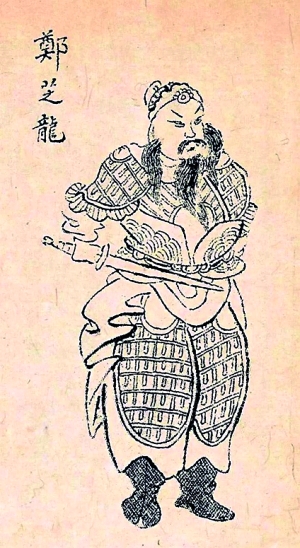 Despite all of
his wealth and power, Zheng Zhilong wanted
something he did not have. When a youth,
formal education and advancement in
Chinese society were not high on his to-do
list. He excelled in hands-on training and
real-world experiences more than rigorous
and tedious book learning and civil
examinations. Both of those were what
permitted men to be seen as honorable and
worthy. These were two traits that he
desired, and events in greater China were
about to provide him with that
possibility. Despite all of
his wealth and power, Zheng Zhilong wanted
something he did not have. When a youth,
formal education and advancement in
Chinese society were not high on his to-do
list. He excelled in hands-on training and
real-world experiences more than rigorous
and tedious book learning and civil
examinations. Both of those were what
permitted men to be seen as honorable and
worthy. These were two traits that he
desired, and events in greater China were
about to provide him with that
possibility.
Although the Ming dynasty ruled Manchuria,
their control over northeast China was
tenuous. As the Manchus
gained power there, the Ming emperor, his
councilors, and his officers neither
needed nor could afford to fight on two
fronts, so when members of the Quanzhou
aristocracy proposed that Zheng Zhilong be
offered a pardon, the emperor listened.
Now, it really wasn’t appropriate for him
to accept bandits into his government, but
if Zheng Zhilong’s pirates would disband,
the emperor was willing to forgive Zheng
Zhilong’s past indiscretions and give him
official standing within the Ming
government in Fujian. It would, of course,
be a provisional appointment, since he did
have to make amends. For the next three
years he was expected to go pirate hunting
and rid the seas of these marauders. When
the probationary period ended, he would
receive an official military rank.
Not all of the gentry agreed with this
plan; surely the emperor had heard the
rumors that quite a few government
officials in Fujian were on the pirate’s
payroll, and perhaps even within the royal
court. Perhaps so, but Zheng Zhilong
possessed what the emperor needed: men who
could fight; local connections; control of
the profitable trade between Fujian and
Taiwan; and fortified bases not only in
Amoy but also in other locations. With
pros outweighing cons, the emperor sent
Cai Shanzhi to see Zheng Zhilong in 1627.
Twenty-two years later, Juan de Palafox y
Mendoza wrote of this affair in his Historia
de la Conquista de la China por el
Tataro (The History of the
Conquest of China by the Tatars).
[B]eing informed of his
valour, the [Emperor] was desirous to
make use of his services in an affair
of high importance to the good and
welfare of his state, and therefore
offered Iquan a general pardon and
indemnity for all that was past . . .
And that he would not only receive him
into grace, but make him High Admiral
or Captain General of all the sea
coasts, give him the office of Great
Mandarin, and abundantly shower upon
him favours and rewards.
(Clements, 57)
Having long
sought honorable respect and prestige,
Zheng Zhilong agreed to the emperor’s
terms.
It just so happened that Zheng Zhilong’s
pirate fleet was one of two plaguing
China’s trade. The other belonged to
Xinsu, who received the same offer from
the emperor. The Ming hope was that the
two pirates would destroy each other, or
at the very least, get rid of one headache
and then the survivor, whose forces would
be weaker, would easily be taken care of
by the Imperial navy.
Although Zheng Zhilong accepted the Ming
offer, he did not immediately carry out
his assignment to get rid of Xinsu. He and
his brother, Hu the Tiger, disagreed about
whether they should work more closely with
the Chinese or the Dutch. Zheng Zhilong
favored the emperor, while Hu preferred
the latter, and they argued for months
over whose respect and recognition would
be of greater value to them. In the end,
Zheng Zhilong’s preference won out and
that is when his fleet sailed against
Xinsu. The Dutch were also on hand, but
came simply to watch the battle unfold.
Palafox wrote, “the courage and conduct of
Iquan quickly gained him the victory,
which he secured by leaping into his
enemy’s ship and with his own hand killing
[Xinsu], and cutting off his head.”
(Clements, 58)
Contrary to what was hoped, the battle did
not weaken Zheng Zhilong. Nor were Ming
officials keen on adhering to the original
agreement; they felt that his power and
sphere of influence had increased to such
an extent that no enemy would or could
oppose him. A major sticking point was the
size of his empire. They wanted him to
downsize. He, however, expected the
emperor to follow through on his offer. A
Fujian official, He Qiaoyuan, was tasked
with trying to get Zheng Zhilong to see
things from the emperor’s perspective.
All your feelings are well
known . . . You do repent of your
behaviour; you do not want to murder
and plunder the people of the
countryside. All people know this. But
of [your] more than ten thousand
followers, why don’t they understand
your feelings? Some of them just want
to fill their mouths and warm their
bodies, others are fortune seekers . .
. Now that you have so many followers
like this, all of them being poor or
bad people, runaway soldiers or
criminals, they behave obsequiously
towards you and become your followers,
and make you ‘The Great King of the
Sea.’ You also enjoy having this
reputation and like to live up to it.
(Clements, 58)
Weeks passed.
Words were exchanged. Finally, Zheng
Zhilong agreed “that his men would no
longer cause clamor, and would be
progressively dispersed.” (Clements, 59)
Going forward, he was to continue to hunt
pirates, specifically those who had once
followed Captain Li Dan but never
acknowledged Zheng Zhilong as his
successor, as a further show of good
faith. The following year, he was
appointed as an imperial admiral and
charged with patrolling the seas.
Not everyone in the Zheng clan or within
Zheng Zhilong’s network was pleased with
his decision to surrender. Chen Zhijing,
his godbrother, convinced a man named
Zhong Bin to double-cross Zheng Zhilong
and attack the Chongwu
fortress. He learned of this
proposed betrayal and seized his
godbrother.
Nor was he the only one to commit
treachery against Zheng Zhilong. An
influential advisor within his
organization did so and was slain. One of
his valued commanders, a man named Li
Kuiqi, absconded with the majority of the
Zheng fleet and men, and seized Xiamen.
Having lost one of his strongholds and
without sufficient vessels to pursue the
turncoat, Zheng Zhilong and one of his
brothers visited Anhai and nearby fishing
villages to cobble together a ramshackle
fleet of fifty vessels and persuaded
fishermen to serve as mercenaries.
Even though the enemy was three times
their size and those crews were skilled
fighters, Zheng Zhilong set sail. Despite
these overwhelming odds, he was counting
on one thing that Li Kuiqi apparently
forgot to initially consider. Among the
crews of the usurped war junks were many
of Zheng’s relatives and their loyalty was
to him first. When the light dawned on Li
Kuiqi that his ships carried enemies as
well as friends, he gathered up all of
those loyal to Zheng Zhilong and executed
them. Learning of this, Zheng retreated
but kept his substitute force at the ready
and trained the crews to fight. When the
opportunity presented itself and Li Kiqui
was away from Xiamen for a brief time,
Zheng Zhilong took the turncoat’s family
hostage.
Whilst this transpired, discord grew among
Li Kuiqi’s officers. One of these
captains, who hailed from Gangzhou, sent
word to Zheng Zhilong that when the moment
was right, he was willing to change sides.
This was good news, but Zheng Zhilong
would need more to vanquish the snake. He
sought help from his network of friends in
Japan, one of whom was now governor
general of Batavia. Jacques
Specx agreed to lend Zheng a few
Dutch ships to bring down Li Kuiqi. In
February 1630, Zheng’s new fleet and the
heavily-armed Dutch approached Li Kuiqi.
The Gangzhou captain and his men joined
Zheng, and together the three forces
demolished Li Kuiqi and his fleet off the
island of Nan’ao.
The survivors formed a new band of
pirates, led by Liu Xiang. In 1633, they
struck Zheng Zhilong’s home base of Anhai
and slew several members of his family. A
series of battles ensued that came to be
known as “the Fujian navy’s seven great
victories.” (Lu, 141) By the fifth battle,
Liu Xiang’s fleet was showing severe signs
of wear and tear and was not nearly as
powerful as Zheng Zhilong’s. Even so, Liu
Xiang won because he had forced Portuguese
and Dutch captives to man his guns. The
final confrontation took place off the
coast of Guangdong, where Liu Xiang was
slain during the battle. An unknown number
of survivors fled to the northern border
of Fujian, where Chen Peng (Zheng
Zhilong’s most indispensable warrior)
obliterated them. The rest of the pirates
surrendered to Zheng Zhilong.
One Dutchman who was at
odds with Zheng Zhilong was Hans
Putmans, the new governor of Taiwan.
He felt Zheng was not living up to
expectations regarding wider trade with
China. He did not have permission to grant
the Dutchman’s demands, but Putmans
apparently did not or would not see this.
Zheng Zhilong could merely pave the way by
speaking with the new governor of Fujian,
Zou Weilian.
Zou Weilian had passed all the civil
service examinations and had been elevated
from provincial positions to national
ones, a rarity among Chinese mandarins.
When he came to Fujian in 1632, he did so
with express orders from the emperor to
resolve the problems with the Dutch and
the pirates. From his perspective the only
way to get rid of one was to get rid of
the other. He once wrote that “I’ve
observed that since ancient times, when
Chinese and barbarians mix together, all
kinds of troubles result.” (Andrade, Lost,
32)
The more Putmans dealt with the Chinese,
the more he considered them to be
“deceitful, treacherous, untrustworthy,
craven.” (Andrade, Lost, 33)
In a single word, they were prevaricators.
Therefore, he decided to use them to his
advantage. Since Chinese sailors earned no
more than four tael per annum at most, it
might behoove him to pay them to fight
their own people. The cost would be
minimal from his perspective because the VOC
paid their crews nearly ten times as much
as what the Chinese received, and whatever
booty was captured would finance their
share. To that end, he sent out dispatches
to Chinese sailors to join him in a new
venture that would pit them against Zheng
Zhilong. Some accepted his proposal.
When ready, Putmans set sail for Xiamen.
His fleet consisted of nine Dutch
ships, which Ming scholars described
as being
three hundred feet long,
sixty feet wide, and more than two
feet thick. They have five masts, and
behind them they have a three-story
tower. On the sides are small ports
where they place brass cannons. And
underneath the masts they have huge
twenty-foot-long iron cannons, which,
when fired, can blast holes into and
destroy stone walls, their thunder
resounding for ten miles (several
dozen li). (Andrade, Lost,
36)
Zou Weilian’s
description of these combination merchant
and fighting vessels was similar.
[T]he red-haired barbarians
have ships that are five hundred feet
long and seventy feet wide. They’re
called decked-ships because within
them they have three layers, all of
which have huge cannons facing
outwards that can pierce and split
stone walls, their thunder sounding
for ten miles. . . . The Hollanders’
ability to ravage the sea is based on
this technology. Our own ships, when
confronting Dutch ships, are smashed
into powder. (Andrade, Lost 36)
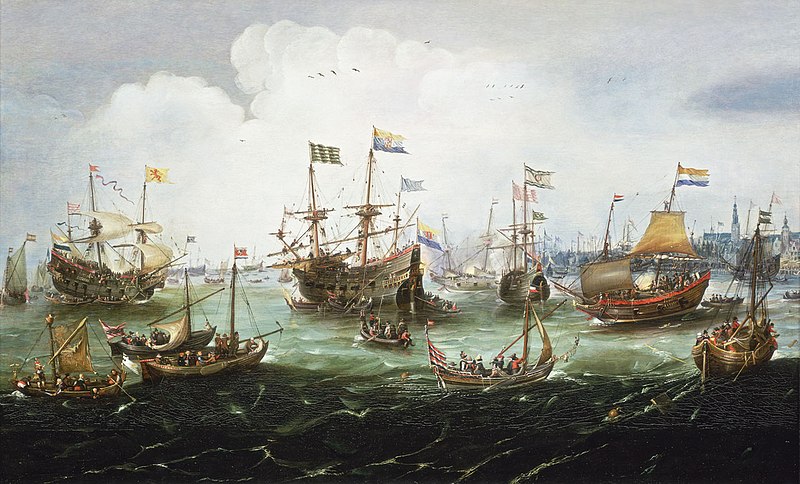
Dutch ships circa early
17th century
(Oil painting by Andries van Eertvelt,
1610-1620, of the second expedition to
the East Indies returning to Amsterdam
in 1599)
(Source: Wikimedia
Commons)
At the time, Zheng Zhilong had shipwrights
building new ships for him, and thirty of
these were based on these Dutch designs.
Each had two gun decks capable of carrying
up to thirty-six large guns on
European-style gun carriages with the
requisite cabling to prevent the guns from
becoming loose cannons and wreaking havoc.
Putmans led his fleet of nine ships to the
far side of Gulangyu, where they anchored
away from prying eyes. At dawn, the fleet
separated into two forces and approached
the harbor from different directions. The
Chinese believed the Dutch were friendly,
so they put up no resistance. The
intruders opened fire. Those aboard the
junks abandoned ship and swam ashore.
Rather than waste gunpowder and shot,
Putmans had his men hack and burn the
Chinese vessels, which provided the Dutch
with no plunder other than fifty iron guns
and firewood. Only three of Zheng
Zhilong’s vessels survived the attack. One
Dutchman died in the assault because he
caught fire while torching one of the
Chinese ships.
Zheng Zhilong’s response, housed within
VOC archives, was a mix of shock and
anger.
You’ve behaved like a
pirate! Are you proud of yourself?
Attacking without warning . . .? If
you had told me in advance, I would
have come out like a soldier and
fought openly, and whoever won would
have deserved the victory, but I
thought you had come as a friend, to
trade and do business. I’ll bide my
time. Don’t believe that you and your
forces will be allowed to remain here
in the imperial waterways for long.
(Andrade, Lost, 42)
Putmans didn’t
take the threat seriously and continued
pillaging like a pirate. The Chinese were
unable to stop him because their vessels
“are tall and large, while ours are low
and small, so we can’t attack them from
below like that.” (Andrade, Lost,
43) He garnered a wide assortment of booty
from watermelons to lacquer tables, from
deerskins to cloves. One haul from a
vessel returning from the Philippines
netted him 27,994 pieces of eight (roughly
$8,128,437 in 2023). All told, the Dutch
reckoned they captured cargo valued at
64,017.25 pieces of eight ($17,611,614).
Plunder taken was a dividend rather than
Putmans’s endgame. He just wanted to put
the Chinese out of action and force them
to give into his demand of free trade for
the Dutch with China. To his way of
thinking Zheng Zhilong was afraid;
certainly, quite a few pirates felt that
might be true, because by the time October
came, 450 sailed with the Dutch.
What Putmans didn’t realize was that his
actions had forced two opposing forces
(Zheng Zhilong and Zou Weilian) to form
their own alliance. They set aside their
differences to stop the Dutch. Shipwrights
returned to shipyards to reconstruct Zheng
Zhilong’s new fleet. Zou Weilian mustered
military leaders to bring arms of all
sizes. Together, these disparate forces
vowed to fight to the death.
While Putmans was out plundering, Zheng
Zhilong was waging his own version of
subterfuge, teasing him with the
possibility of compromise. Then he sent
another missive, this one very different
in tone.
How can a dog be permitted
to lay its bitch head on the emperor’s
pillow? . . . If you want to fight,
bring it to us here in Xiamen, where
the high officials of China can watch
our victory over you. (Andrade, Lost,
45)
The signatures
of twenty-one commanders appeared at the
end of the letter. Putmans was offended
and considered it more swagger than a real
threat. Still his fleet sailed to Liaolua
Bay, and all the vessels flew blue flags
bearing the letters VOC.
Early the next morning an odd assortment
of 150 vessels approached. They belonged
to Zheng Zhilong, who wrote:
It was just daybreak when
we saw the barbarians’ decked ships .
. . nine of them, cocky and self
satisfied with the cliffs at their
back, accompanied by fifty pirate
ships sailing back and forth around
them. (Andrade, Lost, 47)
But this
approaching eclectic armada was not what
Putmans expected. He saw what Zhilong
wanted him to see.
[T]hey were extremely well
supplied with guns and men, and they
comported themselves bravely and
without fear, so we concluded that
these were all warjunks and therefore
expected that – with God’s help – we
would be victorious. . . .
The
Chinese came forth like insane,
forsaken, crazy, desperate men, who
had already given up their lives,
showing no fear of any violence of
cannons, muskets, fire, or flame. (Andrade,
Lost, 47-48)
And then it was
too late. Two opposing vessels slammed
into each other and “went up in an instant
in such terrifying tall flames, burning so
vehemently, that it seemed nearly
impossible.” (Andrade, Lost, 48)
When the flames reached the magazine where
the gunpowder was stored, the vessels
exploded, killing Dutch and Chinese alike.
Despite the conflagration, the Chinese
soldiers didn’t stop with just the one
ship. They boarded another and clashed in
hand-to-hand combat, driven by the promise
that if they seized this second vessel,
they would receive accolades of the
highest order. More vessels came together
and the flames spread.
Zheng Zhilong described the scene.
When the decked ships were
burning, the fire and smoke soared up
to the heavens, and our eyes were
filled with the sight of floating
corpses, while the bodies of those who
were captured and beheaded piled up in
heaps. (Andrade, Lost, 49)
The truth
finally dawned on Putmans.
[T]his entire fleet had
been prepared as fireships and they’d
had no intention of doing battle,
planning instead to come up against us
and set fire to our ships. This was
despite the fact that these were
well-armed and large vessels, the very
best warjunks. We had no chance of
victory since they enjoyed odds of
twenty against one and didn’t care
about their own lives. (Andrade, Lost,
49)
Putmans’s flag
ship fled. Zheng Zhilong pursued. But fate
intervened with “wild” “sea wind” and
“rough and treacherous” “waves.” (Andrade,
Lost, 49)
When a final tally was taken, Putmans lost
four of his nine ships. Ninety-three men
were gone, although how many of those died
or were taken prisoner is unknown. Among
the prizes Zheng Zhilong took were “six
large cannons, two little cannons, sixteen
muskets, eleven barbarian swords, one iron
helmet, six tubes of gunpowder, seven
barbarian books, one sea chart, three
suits of armor.” (Andrade, Lost,
50) His captives included Chinese pirates,
two of their wives, and an undefined
number of Japanese pirates. The emperor
and his court considered this win a
“miracle at sea.” From Zheng Zhilong’s
perspective,
[i]t seems that this
victory is enough to reestablish the
prestige and authority of China, and,
in contrast, to lower the spirits of
those crafty barbarians. (Andrade,
Lost, 50)
The strange
bedfellows that brought about this victory
proved particularly rewarding to Zheng
Zhilong. He could still use the Dutch, and
Ming officials felt he was the only person
capable of managing them. Therefore, why
did he need Zou Weilian around to get in
his way?
He took Zou Weilian’s place as governor,
and once free to continue as he deemed
best, Zheng Zhilong resumed trading with
the Dutch. Mostly he sent his ships to
Taiwan, rather than allowing their ships
to come to him. He decided how much silk
they could purchase and told them how much
it would cost.
During his time as admiral, Zheng Zhilong
taxed ship cargoes at forty percent and
insisted that ships pay for protection.
The latter was the only way to avoid being
plundered by pirates. In exchange for the
extorted sum of 3,000 in gold, merchant
captains received a flag emblazoned with
the Chinese character “Zheng” (Serious).
Few ship owners refused to pay. Ships also
had to pay tolls, and when combined with
the taxes (or extortion fees), these
proved quite profitable. The tolls his men
collected equated to around 10,000,000
taels per annum. His trade with Japan and
Southeast Asia garnered two to three times
that amount. Add to that what he took in
from rents and other land resources, as
well as bribes, and his annual income
probably surpassed that of the VOC three
or four times over.
Around this time, Zheng built a new home
in Anping, north of the island of Jinmen
on the mainland and south of Quanzhou. The
opulent palace was surrounded by a
three-mile outer wall. Guards walked along
parapets of the compound to protect the
interior and his family. The garden
included fountains, ponds with fish,
pavilions, tea-houses, and a small zoo of
exotic animals. “A canal led directly to
his personal residence, and it was said
that it even stretched to his own bedroom
so he could board a ship at a moment’s
notice.” (Andrade, Lost, 53) He also had a
private chapel in which he displayed the
Catholic crucifix and various statues of
Chinese deities. When all was ready, Zheng
Zhilong summoned his seven-year-old son,
often called Lucky Pine, to come live with
him. His mother, Tagawa, remained in
Japan. When Lucky Pine arrived, Zheng
Zhilong embraced this son whom he had
never seen and called him Zheng Sen
(Forest). Each evening, the young boy
“would face east and look to his mother,
hiding his tears.” (Clements, 72)
Zheng Zhilong wished for his first love to
join him. She had not come with their son
because the Japanese were not permitted to
leave their country. So, in 1646, Zhilong
sought permission from the authorities of
the Tokugawa shogunate to allow Tagawa
Matsu to emigrate. Permission was granted,
but she was forced to leave behind another
son.
In June 1644, the Manchu
invaders captured Beijing and established
the Qing dynasty.9
Initially, the Zheng clan pledged
allegiance to the Ming dynasty and vowed
to see the rightful emperor restored to
the throne. Rather than allow the Manchus
to capture him, the Ming emperor committed
suicide near the end of April. While the
Qing ruled from Beijing, the Ming
established a southern
dynasty. The first of these, the Hongguang
emperor, was captured in 1646 and
executed in Beijing. He was succeeded by
the Longwu
emperor, who sought refuge in Fujian
province. Whether Zheng Zhilong decided to
be proactive or thought his best chances
of survival lay with the Qing
court, he negotiated with their
representatives and changed sides,
retaining his position of power in Fujian.
This allowed the Manchus to capture the
province, as well as the Longwu emperor
who was taken and slain in October.
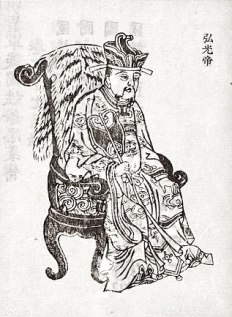 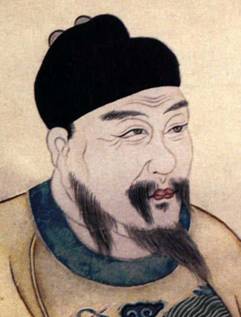 Left: Hongguang
Emperor, also known as Zhu Yousong, by unknown
artist (Source: Wikimedia
Commons)
Left: Hongguang
Emperor, also known as Zhu Yousong, by unknown
artist (Source: Wikimedia
Commons)
Right: Longwu Emperor, also known as Zhu Yujian,
by unknown artist (Source: Wikimedia
Commons)
As the Manchus swept through Fujian, they
also captured Quanzhou, where Tagawa Matsu
lived. Some accounts say that they ravaged
her and afterward, she committed suicide.
Or perhaps she took her own life to
prevent herself from falling into their
clutches. No matter which was true, her
death had a profound impact on her son.
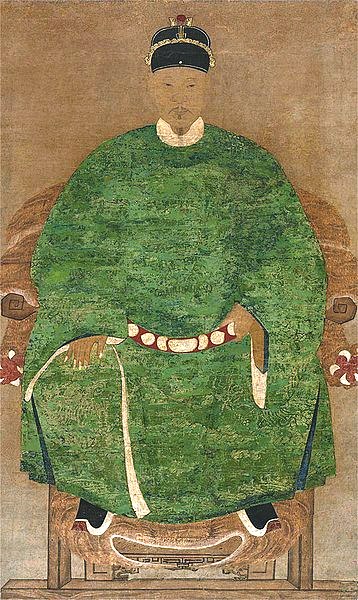 The Zheng Bu ceased to
exist after this. Some of its generals
joined the Southern Ming emperor’s
government. Others became local military
commanders. Those who remained fully loyal
to the Zheng
clan joined Zheng
Chenggong, who assumed leadership of
his father’s organization. Unlike his
father, he remained loyal to the Ming
dynasty, and eventually was honored with a
name that meant “Lord with the Imperial
Surname,” which Europeans translated to
Koxinga (also spelled Coxinga). The Zheng Bu ceased to
exist after this. Some of its generals
joined the Southern Ming emperor’s
government. Others became local military
commanders. Those who remained fully loyal
to the Zheng
clan joined Zheng
Chenggong, who assumed leadership of
his father’s organization. Unlike his
father, he remained loyal to the Ming
dynasty, and eventually was honored with a
name that meant “Lord with the Imperial
Surname,” which Europeans translated to
Koxinga (also spelled Coxinga).
Unfortunately for Zheng Zhilong, the Qing
court did not keep their promises to him
for long. Prince Bolo distrusted him,
believing that he was double dealing,
playing one side against the other, for
his own advantage. Prince Bolo ordered him
to be placed in chains and escorted to
Beijing. A Franciscan friar described his
capture in a letter.
The prince and lord of this
city of Anhai, of these ports and
frontiers, is the mandarin who is
called Yquam [Iquan], whose beginnings
were in making himself feared by the
power he had at sea. He, because of
the fear which the Tartar King [the
Qing emperor] had of him, was summoned
and taken by design to the court of
Beijing, where he is detained, he
being given hope that he will be sent
back to his lands and will be given
absolute rule over this province of
Fujian, that of Guangdong, and another
which adjoins them. Pending his
return, this city and these ports are
governed by the same people whom he
left in charge, which are in this city
of Anhai a mannish woman, his
stepmother [una varonil mujer, su
madrastra], in a related port his
brother, another [brother] in Amoy
[Xiamen], and in his lands a son of
his who now with more than one hundred
thousand men is at sea to make war
against the Tartars if they do not
release his father. (Wills, 124)
The Qing court
held Zheng Zhilong in Beijing under house
arrest. His accommodations befitted those
of a prince, but he was kept away from
most of his family. Despite his seclusion,
he still conducted business and made new
friends, including local Jesuit priests.
He even provided money for them to build a
new church.
Thinking they might better control him and
through him, his son, Qing emissaries
persuaded Zheng Zhilong to bring his son
into their fold. In fact, if he brought
the rest of the Zheng clan over to their
side, he would be released. He and his son
exchanged letters. In his second one,
Zheng Zhilong wrote:
The Manchu court offers
territory in exchange for peace. They
wish to send two noblemen to present
you with the title and deeds of the
Dukedom of Haicheng, allowing your
followers to abide in the region.
(Clements, 149) 10
But Zheng
Chenggong had learned well from his
father. He did not trust the Manchus, and
he had no intention of forsaking the Ming
emperor.
Two years later, Zheng Zhilong wrote
another letter, but this one was not at
the behest of his jailers. His words were
meant only for his son, and the missive
was to be smuggled out of the city by
those who still supported the Zheng clan.
What Zhilong wrote and how the document
ended up in Manchu hands remains unknown,
but the contents were sufficient to
abruptly end the Qing emperor’s efforts to
bring Zheng Chenggong into the fold. Zheng
Zhilong was divested of all his titles and
thrown in prison with other members of his
family, including one of his sons and Bao
the Panther, his brother. He was also
sentenced to die, but that judgement was
not carried out immediately.
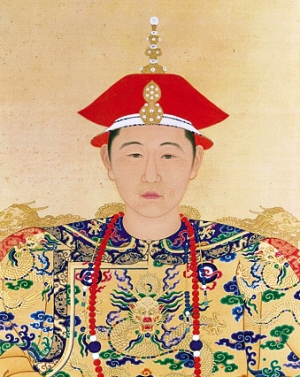 When the first Qing emperor
died of smallpox in February 1661, his
third son became the Kangxi
Emperor. He was only seven years
old, so Manchu members of the royal court,
who had also served his father, acted as
regents. They decided it was time to carry
out Zheng Zhilong’s sentence, announcing
on 24 November that he would endure lingchi.
This ritualistic death by a thousand cuts
involved single cuts in a specific order:
“fleshy parts – thighs, calves, and
breasts – were dealt with first, followed
by appendages such as the nose, ears,
fingers and toes.” With surgical skill the
executioner dismembered the convicted
piece by piece, ending “the butchery by
stabbing the man through the heart, and
decapitating him.” (Abbott, 381) When the first Qing emperor
died of smallpox in February 1661, his
third son became the Kangxi
Emperor. He was only seven years
old, so Manchu members of the royal court,
who had also served his father, acted as
regents. They decided it was time to carry
out Zheng Zhilong’s sentence, announcing
on 24 November that he would endure lingchi.
This ritualistic death by a thousand cuts
involved single cuts in a specific order:
“fleshy parts – thighs, calves, and
breasts – were dealt with first, followed
by appendages such as the nose, ears,
fingers and toes.” With surgical skill the
executioner dismembered the convicted
piece by piece, ending “the butchery by
stabbing the man through the heart, and
decapitating him.” (Abbott, 381)
Thomas Taylor Meadows wrote of witnessing
such an execution in 1851. The
executioner
proceeded, with a single-edged dagger
or knife, to cut up the man on the
cross: whose sole clothing consisted
of his wide trousers, rolled down to
his hips and up to his buttocks. He
was a strongly-made man, above the
middle-size, and apparently about
forty years of age. . . . we observed
the two cuts across the forehead, the
cutting off of the left breast, and
slicing of the flesh from the front of
the thighs . . . From the first stroke
of the knife till the moment the body
was cut down from the cross and
decapitated, about four or five
minutes elapsed. (Meadows,
655-656)
 To make Zheng
Zhilong’s execution more gut-wrenching, he
would first have to watch two sons and
eight others undergo this form of torture
first. When the execution day arrived, the
Qing court altered their pronouncement;
instead of dying by lingchi, Zheng Zhilong
and the others would be decapitated.
Afterwards, all of the Zheng family’s
property and wealth was seized, and their
ancestral graves destroyed. To make Zheng
Zhilong’s execution more gut-wrenching, he
would first have to watch two sons and
eight others undergo this form of torture
first. When the execution day arrived, the
Qing court altered their pronouncement;
instead of dying by lingchi, Zheng Zhilong
and the others would be decapitated.
Afterwards, all of the Zheng family’s
property and wealth was seized, and their
ancestral graves destroyed.
During his lifetime, Zheng Zhilong
mastered many skills and finessed many
people in his climb from obscurity to the
lofty realms of a sea lord. He was canny
and had a knack for military tactics. If
his enemy thought him in front of them, in
reality he was behind them. He began
writing a strategy handbook entitled Jing
guo xionglue (Grand Strategy for
Ordering the Country) while in Japan in
1612. (The original twenty chapters were a
gift for the founder of the Tokugawa
Shogunate.) This handbook became a
work-in-progress that had reached eighty
chapters in 1645.
Father Vittorio Riccio, a Dominican
missionary and contemporary of both Zheng
Zhilong and his son, said of the former:
Nicolas the apostate, a
marvel of human fate, who rose up by
most despicable chance to challenge
kings and emperors. (Ho, 263)
Notes:
1. Although the Latin
words translate to ten gold coins in gold,
it is more likely that the Jesuits gave
Zheng Zhilong ten silver taels. At the
time, one of these coins would be enough
to purchase more than 166 pounds of flour.
2. Wakō,
referring to where the pirates originated
rather than their race, are often thought
of as Japanese. In reality, they were
Chinese.
3. The Matsura ruled
Hirado from 1603 to 1868, but their roots
there trace back to 794. Prior to Tokugawa
Ieyasu gaining control over all of Japan
and establishing the Tokugawa Shogunate,
the Matsura supported a different leader.
To show that they now supported the new
shogunate, the head of the Matsura torched
his new castle
in 1613. Eventually, the family gained
high standing within the Tokugawa
Shogunate during the seventeenth century.
4. It’s possible that
Zheng Zhilong delved into piracy early in
his sea career. In 1622, there were three
pirate leaders operating out of Fujian,
China: Yang Lu, Cai Wu, and Zhong Bu. The
latter two got into a scuffle with naval
commander Yu Zigan. He won; Cai Wu fled to
Japan and Zhong Bu lurked around Taiwan.
This defeat gave Yang Lu greater power;
the pirates giving their allegiance to him
numbered 3,000 and they served aboard
seventy-two junks. Zheng Zhilong, a
small-fry among the unallied pirates,
offered to join Yang Lu, but he refused.
This might be how he came to join Li Dan’s
organization.
5. Lady Yan was the
daughter of one of Li Dan’s associates.
She would give Zheng Zhilong four sons:
Shixi, Shidu, Shiyin, and Shi’en.
He also had two daughters (mother unknown)
who were raised in the Catholic faith. One
would marry a Portuguese man named Antonio
Rodrigues, whose father had ties with
Zheng Zhilong on Anhai.
6. Tael was a
means for measuring silver in China. It
was recorded in accounting ledgers to show
the amount of a transaction and what it
was worth. Payments were made in actual
silver or foreign currency, depending on
whether the trade was made in China or
transacted with outlanders. The actual
measure of a tael varied because
there was no uniformity in scales and
regions, but according to Encyclopedia
Britannica “most were
equivalent to 1.3 ounces of silver.”
7. China’s first
emperor, Shi Huang Di, unified basic
measurements after he came to power in 221
BCE. The shi or dan was
a measurement of weight and was equivalent
to the weight a man could tote around on a
shoulder pole. During the Ming dynasty,
one shi was equal to 100 jin
and 1 jin has been equated to
590 grams in the metric system of weights,
which did not exist during the Ming
dynasty. Thus, 3,000 shi =
300,000 jin = 177,000,000 grams.
9,000 shi = 900,000 jin =
531,000,000 grams.
8. Among his many
lieutenants (commanders of his junks) were
his younger brothers Bao the Panther and
Hu the Tiger and his half-brother Peng the
Roc. In addition to blood relatives, Zheng
Zhilong often adopted the offspring of the
poor and destitute, whom he raised to
become viable members of his crews. One of
these boys was named Zheng Tai, a sullen
and stubborn lad whose own family showed
him no respect. Zheng Zhilong took him
under his wing, and Zheng Tai rose through
the ranks and outlived many of those who
thought he would never amount to anything.
9. Once Beijing fell,
war would be waged for four decades before
the Qing dynasty gained complete control
of China.
10. This passage is a
summarized version of Zheng Zhilong’s
words and were recorded in Yang Ying’s Xian
Wang Shi Lu Jiao Zhu (Notes on the
Records of the First Kings) around 1661.
Resources:
Abbott, Geoffrey. “Thousand
Cuts,” The Book of Execution: An
Encyclopedia of Methods of Judicial
Execution. Headline, 1994,
380-383.
Andrade, Tonio. Lost Colony: The
Untold Story of China’s First Great
Victory over the West. Princeton
University, 2011.
Andrade, Tonio, and Hang Xing. "The East
Asian Maritime Realm in Global History,
1500-1700," Sea Rovers, Silver, and
Samaurai, 1500-1700 edited by
Tonio Andrade and Hang Xing. University
of Hawai'i, 2019, 1-27.
Antony,
Robert J. “Introduction: The Shadowy
World of the Greater China Seas,” Elusive
Pirates, Pervasive Smugglers: Violence
and Clandestine Trade in the Greater
China Seas edited by Robert J.
Antony. Hong Kong University, 2010,
1-14.
Antony, Robert J. Like Froth
Floating on the Sea: The World of
Pirates and Seafarers in Late Imperial
South China. Institute of East
Asian Studies, University of California,
2003.
Antony,
Robert J. Pirates in the Age of Sail.
W. W. Norton & Co., 2007.
Blusé, Leonard. “Shame and Scandal in
the Family: Dutch Eavesdropping in the
Zheng Lineage,” Sea Rovers, Silver,
and Samurai: Maritime East Asia in
Global History, 1550-1700 edited
by Tonio Andrade and Hang Xing.
University of Hawai’i, 2019, 226-237.
Calanca, Paola. “Piracy and Coastal
Security in Southeastern China,
1600-1780” in Elusive Pirates,
Pervasive Smugglers: Violence and
Clandestine Trade in the Greater China
Seas edited by Robert J. Antony.
Hong Kong University, 2010, 85-98.
Carioti, Patrizia. “The Zheng Regime and
the Tokugawa Bakufu: Asking for Japanese
Interventions,” Sea Rovers, Silver,
and Samurai: Maritime East Asia in
Global History, 1550-1700 edited
by Tonio Andrade and Hang Xing.
University of Hawai’i, 2019, 156-180.
Carter, James. “China’s
Great Pirate, Zheng Zhilong, Takes on
the Dutch,” The China Project (20
October 2021).
Chinese
Names – Rules, Meanings, Taboos, and
Classic Examples. Chinese
Fetching.
Chinese
Weights and Measures. Chinasage.
Clements, Jonathan. Coxinga and the
Fall of the Ming Dynasty. Sutton,
2005.
“The
Company’s Chinese Pirates: How the
Dutch East India Company Tried to Lead a
Coalition of Pirates to War against
China, 1621-1662,” History
Cooperative.
Day, A. Grove. Pirates of the
Pacific. Meredith Press, 1968.
Eminent Chinese of the Ch’ing Period
(1644-1912) edited by Arthur W.
Hummel. United States Government
Printing Office, 1944, II: 638-639.
Emmer, Pieter C., and Joseph J. L.
Gommans. The Dutch Overseas Empire,
1600-1800 translated by Marilyn
Hedges. Cambridge University, 2021.
Hang Xing. Conflict and Commerce in
Maritime East Asia: The Zheng Family
and the Shaping of the Modern World,
c. 1620-1720. Cambridge
University, 2017.
Harris, Lane J. “Terms
of Measurement, Units of Currency, and
Bureaucratic Titles,” The
Peking Gazette: A Reader in
Nineteenth-Century Chinese History.
Brill, 2018.
Ho, Daphon David. “The Burning Shore:
Fujian and the Coastal Depopulation,
1661-1683,” Sea Rovers, Silver, and
Samurai: Maritime East Asia in Global
History, 1550-1700 edited by Tonio
Andrade and Hang Xing. University of
Hawai’i, 2019, 260-289.
Konstam, Angus. Piracy: The Complete
History. Osprey, 2008.
Laver, Michael. “Neither Here
nor There: Trade, Piracy, and the
‘Space Between’ in Early Modern East
Asia,” Sea Rovers, Silver, and
Samurai: Maritime East Asia in
Global History, 1550-1700 edited
by Tonio Andrade and Hang Xing.
University of Hawai’i, 2019, 28-37.
Lu Cheng-heng. “Between Bureaucrats
and Bandits: The Rise of Zheng Zhilong
and His Organization, the Zheng
Ministry (Z Bu),” Sea
Rovers, Silver, and Samaurai: Maritime
East Asia in Global History, 1550-1700 edited by
Tonio Andrade and Hang Xing.
University of Hawai’i, 2019, 132-155.
Meadows, Thomas Taylor. The
Chinese and Their Rebellions.
Academic Reprints, 1856, 655-656.
Piracy
in Historical Asia.
Crossroads Research Centre. 2022.
Shapinsky, Peter D. “Envoys and Escorts:
Representation and Performance among
Koxinga’s Japanese Pirate Ancestors,” Sea
Rovers, Silver, and Samurai: Maritime
East Asia in Global History, 1550-1700
edited by Tonio Andrade and Hang Xing.
University of Hawai’i, 2019, 38-64.
Shapinsky, Peter D. “From Sea Bandits to
Sea Lords: Nonstate Violence and Pirate
Identities in Fifteenth- and
Sixteenth-Century Japan” in Elusive
Pirates, Pervasive Smugglers: Violence
and Clandestine Trade in the Greater
China Seas edited by Robert J.
Antony. Hong Kong University, 2010,
27-41.
Smits, Gregory. “Rethinking
Early Ryukyuan History,” The
Asia-Pacific Journal 17:7:1 (1
April 2019).
Theobald, Ulrich. Duliangheng,
weights and measures.
ChinaKnowledge.de.
Turnball, Stephen. Pirate of the Far
East 811-1639. Osprey, 2007.
Vermote, Frederick. “The Role of Urban
Real Estate in Jesuit Finances and
Networks between Europe and China,
1612-1778.” PhD diss., The University of
British Columbia, Vancouver, 2013.
Wills, Jr., John E. “Yiguan’s
Origins: Clues from Chinese, Japanese,
Dutch, Spanish, Portuguese, and Latin
Sources,” Sea
Rovers, Silver, and Samaurai: Maritime
East Asia in Global History, 1550-1700 edited by
Tonio Andrade and Hang Xing.
University of Hawai’i, 2019, 114-131.
Xu Ke. “Piracy, Seaborne Trade and the
Rivalries of Foreign Sea Powers in
East and Southeast Asia, 1511 to 1839:
A Chinese Perspective,” Piracy,
Maritime Terrorism and Securing the
Malacca Straits edited by Graham
Gerard Ong-Webb. International
Institute for Asian Studies and
Institute of Southeast Asian Studies,
2006, 221-240.
Copyright ©2023 Cindy Vallar
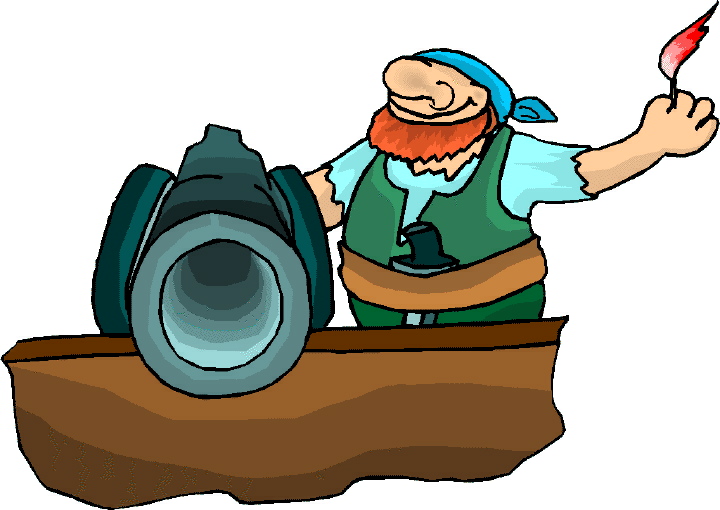
Click to contact me
Background image compliments
of Anke's Graphics |

